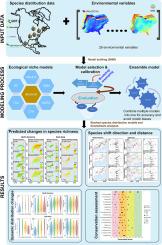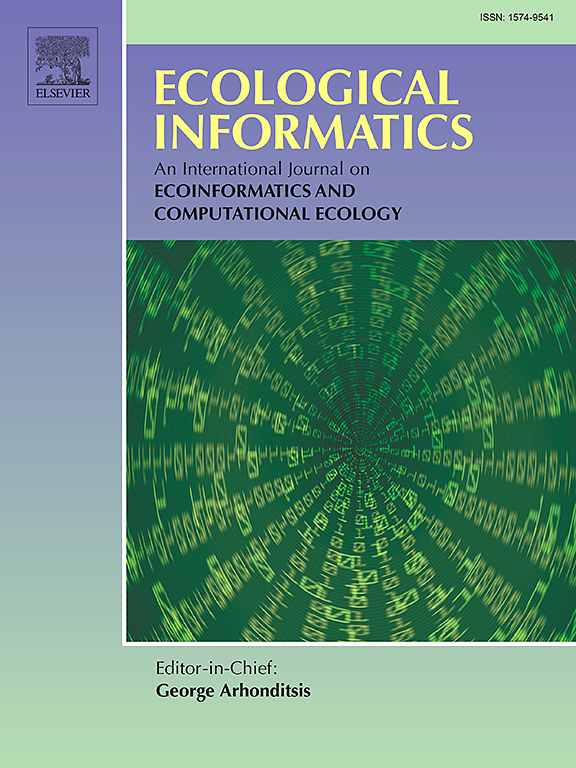Shrinking horizons: Climate-induced range shifts and conservation status of hickory trees (Carya Nutt.)
IF 5.8
2区 环境科学与生态学
Q1 ECOLOGY
引用次数: 0
Abstract
Understanding the intricate interplay between the geographic distributions of species and the dynamics of environmental factors is crucial for effective biodiversity management. Crop wild relatives are important resources for the improvement of cultivated plants. However, our understanding of how these species might respond to future climatic changes and their implications for conservation remains incomplete. In this study, we focus on the ecologically and economically significant hickory trees to address this knowledge gap. We employed the Biomod2 ensemble model to predict the potential distributions of 12 North American and five East Asian Carya species based on 13,643 occurrence points and 26 environmental variables. We analyzed the distribution range dynamics of hickory trees across the past, present, and future emission scenarios (2090; SSP126 and SSP585), assessed their conservation status, and conducted a preliminary threat assessment. Our results indicate that most Carya species expanded their habitat range from the Last Glacial Maximum to the present, with substantial contraction projected under both future scenarios. A northward migration shift to high elevations was observed for most species from the LGM to the future. Sixteen species were categorized as “medium priority” for further conservation action, and only one (C. tonkinensis) as “high priority”. Preliminary threat assessment classified one species (C. luana) as critically endangered, eight endangered, four vulnerable, and five as least concern. This study underscores the potential effects of climate change on the distribution of Carya species, providing crucial insights for their conservation and highlighting the broader impacts of climate change on crop wild relatives.

缩小的地平线:气候引起的山核桃树(Carya Nutt.)
了解物种地理分布与环境因素动态之间错综复杂的相互作用,对于有效管理生物多样性至关重要。作物野生近缘种是改良栽培植物的重要资源。然而,我们对这些物种如何应对未来气候变化及其对保护的影响的了解仍然不全面。在本研究中,我们重点研究了具有重要生态和经济意义的山核桃树,以填补这一知识空白。我们利用 Biomod2 组合模型,基于 13643 个发生点和 26 个环境变量,预测了 12 个北美山核桃树种和 5 个东亚山核桃树种的潜在分布。我们分析了山核桃树在过去、现在和未来排放情景(2090 年;SSP126 和 SSP585)下的分布范围动态,评估了它们的保护状况,并进行了初步的威胁评估。我们的研究结果表明,从末次冰川极盛时期到现在,大多数山杉树物种的栖息地范围都在扩大,而在两种未来情景下,它们的栖息地范围预计都会大幅缩小。从末次冰期到未来,大多数物种都向高海拔地区北移。有 16 个物种被列为 "中度优先",需要采取进一步保护措施,只有一个物种(C. tonkinensis)被列为 "高度优先"。初步威胁评估将一个物种(C. luana)列为极度濒危,八个濒危,四个易危,五个最不值得关注。这项研究强调了气候变化对 Carya 物种分布的潜在影响,为保护这些物种提供了重要的启示,并突出了气候变化对作物野生近缘种的广泛影响。
本文章由计算机程序翻译,如有差异,请以英文原文为准。
求助全文
约1分钟内获得全文
求助全文
来源期刊

Ecological Informatics
环境科学-生态学
CiteScore
8.30
自引率
11.80%
发文量
346
审稿时长
46 days
期刊介绍:
The journal Ecological Informatics is devoted to the publication of high quality, peer-reviewed articles on all aspects of computational ecology, data science and biogeography. The scope of the journal takes into account the data-intensive nature of ecology, the growing capacity of information technology to access, harness and leverage complex data as well as the critical need for informing sustainable management in view of global environmental and climate change.
The nature of the journal is interdisciplinary at the crossover between ecology and informatics. It focuses on novel concepts and techniques for image- and genome-based monitoring and interpretation, sensor- and multimedia-based data acquisition, internet-based data archiving and sharing, data assimilation, modelling and prediction of ecological data.
 求助内容:
求助内容: 应助结果提醒方式:
应助结果提醒方式:


